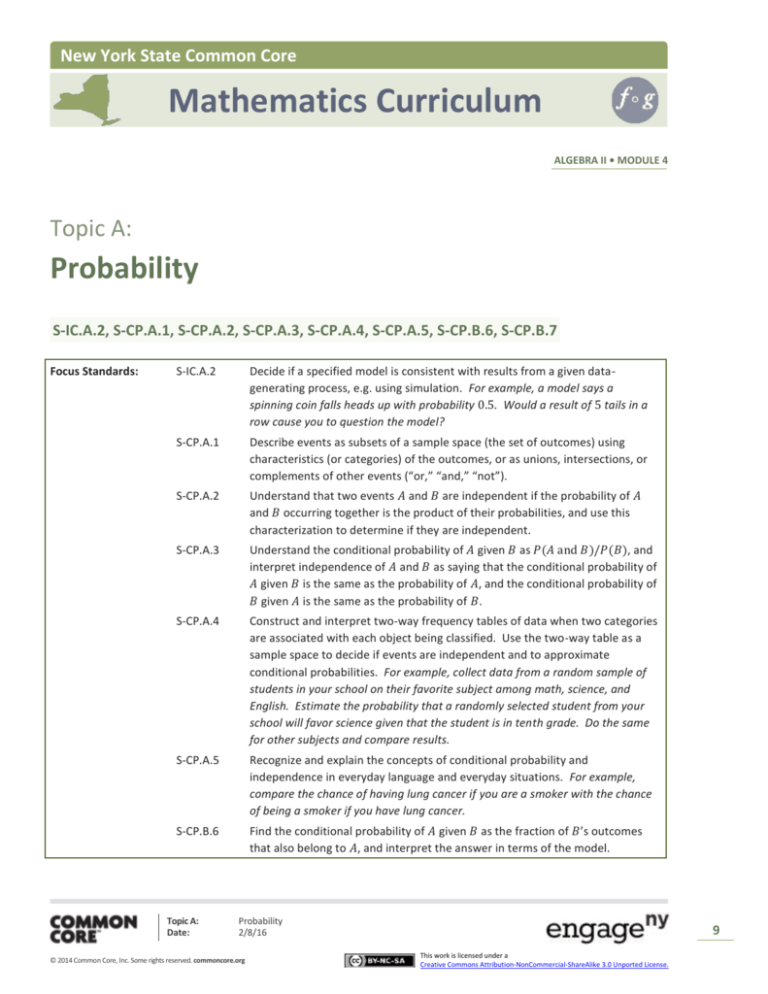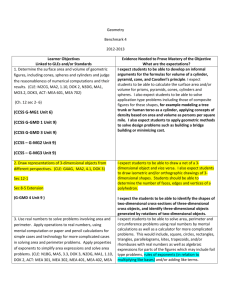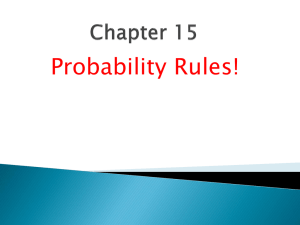
New York State Common Core
Mathematics Curriculum
ALGEBRA II • MODULE 4
Topic A:
Probability
S-IC.A.2, S-CP.A.1, S-CP.A.2, S-CP.A.3, S-CP.A.4, S-CP.A.5, S-CP.B.6, S-CP.B.7
Focus Standards:
S-IC.A.2
Decide if a specified model is consistent with results from a given datagenerating process, e.g. using simulation. For example, a model says a
spinning coin falls heads up with probability 0.5. Would a result of 5 tails in a
row cause you to question the model?
S-CP.A.1
Describe events as subsets of a sample space (the set of outcomes) using
characteristics (or categories) of the outcomes, or as unions, intersections, or
complements of other events (“or,” “and,” “not”).
S-CP.A.2
Understand that two events 𝐴 and 𝐵 are independent if the probability of 𝐴
and 𝐵 occurring together is the product of their probabilities, and use this
characterization to determine if they are independent.
S-CP.A.3
Understand the conditional probability of 𝐴 given 𝐵 as 𝑃(𝐴 and 𝐵)/𝑃(𝐵), and
interpret independence of 𝐴 and 𝐵 as saying that the conditional probability of
𝐴 given 𝐵 is the same as the probability of 𝐴, and the conditional probability of
𝐵 given 𝐴 is the same as the probability of 𝐵.
S-CP.A.4
Construct and interpret two-way frequency tables of data when two categories
are associated with each object being classified. Use the two-way table as a
sample space to decide if events are independent and to approximate
conditional probabilities. For example, collect data from a random sample of
students in your school on their favorite subject among math, science, and
English. Estimate the probability that a randomly selected student from your
school will favor science given that the student is in tenth grade. Do the same
for other subjects and compare results.
S-CP.A.5
Recognize and explain the concepts of conditional probability and
independence in everyday language and everyday situations. For example,
compare the chance of having lung cancer if you are a smoker with the chance
of being a smoker if you have lung cancer.
S-CP.B.6
Find the conditional probability of 𝐴 given 𝐵 as the fraction of 𝐵’s outcomes
that also belong to 𝐴, and interpret the answer in terms of the model.
Topic A:
Date:
Probability
2/8/16
© 2014 Common Core, Inc. Some rights reserved. commoncore.org
9
This work is licensed under a
Creative Commons Attribution-NonCommercial-ShareAlike 3.0 Unported License.
Topic A
NYS COMMON CORE MATHEMATICS CURRICULUM
M4
ALGEBRA II
S-CP.B.7
Instructional Days:
Apply the Addition Rule, 𝑃(𝐴 or 𝐵)– 𝑃(𝐴) + 𝑃(𝐵)– 𝑃(𝐴 and 𝐵), and interpret
the answer in terms of the model
7
Lesson 1:
Chance Experiments, Sample Spaces, and Events (E)1
Lesson 2:
Calculating Probabilities of Events Using Two-Way Tables (P)
Lessons 3–4:
Lesson 5:
Lessons 6–7:
Calculating Conditional Probabilities and Evaluating Independence Using Two-Way Tables (P, P)
Events and Venn Diagrams (P)
Probability Rules (P, P)
Fundamental ideas from Grade 7 are revisited and extended to allow students to build a more formal
understanding of probability. Students expand their understanding of chance experiments, sample space,
and events to the more complex understanding of events defined as unions, intersections, and complements
(S-CP.A.1). Students develop this understanding as they consider events that can be described as unions and
intersections in the context of a game involving cards and spinners. One such game is introduced in Lesson 1,
and then students explore further variations of the game in the lesson’s Problem Set. Students also consider
whether observations from a chance experiment are consistent with a given probability model (S-IC.A.2).
Students also calculate probabilities of unions and intersections using data in two-way data tables and
interpret them in context (S-CP.A.4). Students deepen their understanding by creating “hypothetical 1000”
two-way tables (i.e., tables based on a hypothetical population of 1000 observations) and then use these
tables to calculate probabilities. Students use given probability information to determine the marginal totals
and individual cell counts. This table then allows students to calculate conditional probabilities, as well as
probabilities of unions, intersections, and complements, without the need for formal probability rules.
Students are introduced to conditional probability (S-CP.A.3, S-CP.A.5), which is used to illustrate the
important concept of independence by describing two events, 𝐴 and 𝐵, as independent if the conditional
probability of 𝐴 given 𝐵 is not equal to the unconditional probability of 𝐴. In this case, knowing that event 𝐵
has occurred does not change the assessment of the probability that event 𝐴 has also occurred (S-CP.A.2,
S-CP.A.5). Students use two-way tables to determine if two
events are independent by calculating and interpreting
conditional probabilities. In Lesson 3, students are presented
with athletic participation data from Rufus King High School
in two-way frequency tables, and conditional probabilities are
calculated using column or row summaries. The conditional
probabilities are then used to investigate whether or not
there is a connection between two events.
Students are also introduced to Venn diagrams to represent
the sample space and various events. Students will see how
the regions of a Venn diagram connect to the cells of a twoway table. Venn diagrams also help students understand
probability formulas involving the formal symbols of union,
intersection, and complement. Additionally, a Venn diagram
can show how subtracting the probability of an event from 1
1
Lesson Structure Key: P-Problem Set Lesson, M-Modeling Cycle Lesson, E-Exploration Lesson, S-Socratic Lesson
Topic A:
Date:
Probability
2/8/16
© 2014 Common Core, Inc. Some rights reserved. commoncore.org
10
This work is licensed under a
Creative Commons Attribution-NonCommercial-ShareAlike 3.0 Unported License.
NYS COMMON CORE MATHEMATICS CURRICULUM
Topic A
M4
ALGEBRA II
enables you acquire the probability of the complement of the event and why the probability of the
intersection of two events is subtracted from the sum of event probabilities when calculating the probability
of the union of two events.
The final lessons in this topic introduce probability rules (the multiplication rule for independent events, the
addition rule for the union of two events, and the complement rule for the complement of an event)
(S-CP.B.6, S-CP.B.7). Students use the multiplication rule for independent events to calculate the probability
of the intersection of two events. Students interpret independence based on the conditional probability and
its connection to the multiplication rule.
Topic A:
Date:
Probability
2/8/16
© 2014 Common Core, Inc. Some rights reserved. commoncore.org
11
This work is licensed under a
Creative Commons Attribution-NonCommercial-ShareAlike 3.0 Unported License.








